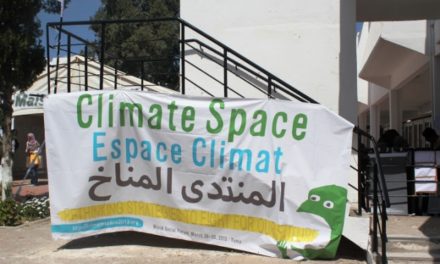By Pablo Solon
In the last 20 years, the greenhouse gas (GHG) emissions in the world have, instead of declining, increased, by more than a third. In 1990, GHG emissions were 37 Gigatons (Gt) of CO2e[1]. In 2010, they surpassed 50 GtCO2e[2]. At this rate, if business-as-usual continues, global emissions can reach 58 GtCO2e by 2020, which would be a catastrophe for humanity and nature.
How much will they decrease with the agreements of Cancun, Durban and Doha?
Following the current scenario, the agreements will only succeed to decrease GHG emissions to 57 GtCO2e by 2020. This means that with the UNFCCC outcomes, projected emissions will only be 1 GtCO2e lower than the business-as-usual level. In other words, global emissions will, instead of decreasing, increase by 7Gt CO2e annually until 2020.[3]
Where do we need to be in 2020 to be on the path of staying below 2ºC?
If we want to stay below 2ºC, we would need to be at 44 GtCO2e per year in 2020[4]. This means that the gap between a below 2ºC scenario and where emissions will be in 2020 is 13 GtCO2e.
Why are humanity and nature in such a very bad situation?
During the past few years, climate justice activists from all over the world have developed several initiatives to try to avoid exactly this disaster. Now is the time to rethink and assess what went wrong in order to find ways to overcome this situation. This is the purpose of the Climate Space at the World Social Forum in Tunisia this March 2013 and the purpose of this paper is just to kick off the debate on this issue.
The idea is to begin the discussion in order to hear the opinions of many that will not be able to come to Tunisia in March. The purpose is to invite you to comment on this paper in http://climatespace2013.wordpress.com orhttp://www.facebook.com/ClimateSpace2013 or email to [email protected]
We have classified some proposed explanations in three big groups: a) campaign, b) governments and negotiations and c) systemic.
Campaign
- Our messages were abstract. There was not a clear link between the percentage of emission reductions and the daily lives of people (for example: the link between climate change, food crisis and financial speculation).
- It was mainly a campaign of climate activists around the climate negotiations in the UNFCCC. We were not able to link the climate struggle with the social movements struggles in relation to hunger, employment, the debt crisis, democracy, water, privatization, etc.
- The campaign was focused mainly on the responsibility of developed countries and not on the polluting projects of corporations and governments all over the world.
- Too much attention was given to the negotiations in the United Nations. Most of the actions happened around COP negotiations. Not enough support was given to promote and coordinate at global and regional levels, the national and local actions against polluting activities (coal, fossil fuels, fracking, mega dams, mining, nuclear, etc.)
- Our campaign against false solutions and market mechanisms was not strong enough. In some cases indigenous peoples and other movements were divided on issues such as REDD, Clean Development Mechanisms, carbon markets, and the green economy.
- Not enough energy was given to the different countries to analyze, unmask and propose different alternatives to National Plans on Climate Change and National Energy Plans.
- Too few initiatives to reclaim the rights of people to decide on climate related issues were developed (consultations, citizen initiatives, etc).
- In the majority of countries there are still no strong national platforms on climate change that bring together all initiatives on climate change.
- Some sectarian attitudes undermine common actions.
Governments/negotiations
- The United States, historically, the biggest emitter, is mainly responsible for the failure of the negotiations. If they are allowed a 3% emission reduction until 2020 based on 1990 levels, others will do the same.
- Unites States and China behind closed doors worked together to have a weak outcome in order to keep business as usual.
- The division between developed and developing countries masks the common interest of the elites and corporations in developed and developing countries.
- The negotiations were reduced to only a number: the percentage of greenhouse gas emission reductions. Other factors were left aside like how the fossil fuel reserves have to be left under the ground.
- The negotiations were too complicated to be followed by the people and there were too many technicalities, loopholes and market mechanisms that made it even worse and more difficult to understand.
- The negotiations were focused on reductions of emissions produced in a country and not in emissions consumed in a country.[5]
- The emissions of warfare and maritime and air transport until now are not included.
- Issues like compliance or the creation of an International Court of Environmental and Climate Justice are far from even being considered.
- The framework of the climate negotiations is the problem and has to change. (How should it change and is this possible in the UNFCCC?)
System
- The economic crisis reduced attention to the climate crisis.
- There was a country approach and not a class approach.
- The issue of endless growth was not challenged because we were attached to the paradigm of development for developing countries. (What is development? What are the limits? Development for whom and how? In other words the link between development, prosperity and redistribution.)
- Corporations have captured the climate negotiations.
- It was naïve to think that an issue like climate change that will severely impact on the capitalist system would be genuinely addressed in an intergovernmental negotiation in the United Nations.
- Climate Change implies a transformation of the capitalist system and a new redefinition of prosperity or wellbeing. The current negotiations can’t deliver a solution at this level.
- Systemic alternatives like food sovereignty, rights of nature, defense of the commons, happiness index and others are still not fully socialized.
- The mistake was to think of it as a campaign and not as a long-standing global battle to change the system.
We have to look into the past to fight for the future
Many of these bullet points are meant simply to push the debate forward. For sure several aspects are missing and the interconnection between them have to be developed. An evaluation of what has happened is key to rethink our strategies and build a common action plan.
(Next living paper: how to overcome this situation?)
[1] CO2e: “Carbon dioxide equivalents” is a unit of measurement that allows the effect of different greenhouse gases and other factors to be compared using carbon dioxide as a standard unit for reference.
[2] “Current global greenhouse gas emissions, based on 2010 data from bottom-up emission inventory studies, are estimated at 50.1 GtCO2e…” UNEP, 2012 Emissions Gap Report.
[3] “If countries implement their lower-ambition pledges and are subject to “lenient” accounting rules, then the median estimate of annual GHG emissions in 2020 is 57 GtCO2e…” UNEP, 2012 Emissions Gap Report
[4] “Emission scenarios analyzed in this report and consistent with a “likely” chance of meeting the 2°C target have a peak before 2020, and have emission levels in 2020 of about 44 GtCO2e…” UNEP, 2012 Emissions Gap Report
[5] One-third of carbon dioxide emissions associated with the goods and services consumed in developed countries are actually being emitted outside the borders of those nations, mostly in the developing world.










